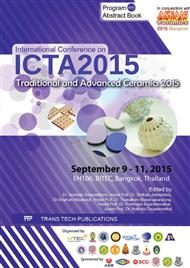p.212
p.218
p.224
p.230
p.236
p.240
p.246
p.252
p.259
Effects of Dissolving Agents on Particle Size Reduction of Titanium Dioxide Synthesized by Solution Combustion Technique
Abstract:
High photocatalytic activity of nanoparticulate titanium dioxide has attracted worldwide attention. Synthesis techniques of the nanoparticles, however, often require high energy supply or costly initial reagents. Solution combustion technique is an energy-effective technique capable of synthesizing nanosized titanium powders. This research aimed at utilizing a less expensive initial reagent in synthesis of nanoparticulate titanium dioxide by the solution combustion technique. The research also examined effects of dissolving agents on chemical composition and particle sizes of the synthesized powders. A low-cost initial reagent, titanium dioxide with average particle size of 154 nanometers, was dissolved in sulfuric acid or dispersed in nitric acid prior to the combustion. Experimental results revealed that the pure anatase phase titanium dioxide was successfully obtained in powders prepared from both sulfuric acid and nitric acid. The average particle size of the powder prepared from sulfuric acid was 77 nanometers, while that of the powder prepared from nitric acid was 117 nanometers. The difference in particle sizes was attributed to solubility of the initial reagent in the acid. Complete solution of initial reagent in sulfuric acid was the main factor attributed to finer particle size.
Info:
Periodical:
Pages:
236-239
Citation:
Online since:
May 2016
Authors:
Keywords:
Price:
Сopyright:
© 2016 Trans Tech Publications Ltd. All Rights Reserved
Share:
Citation:


